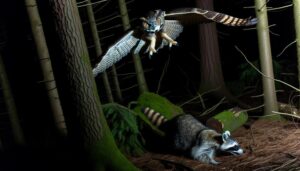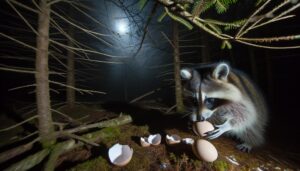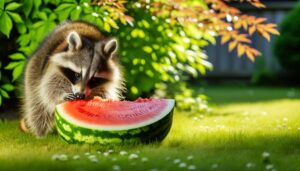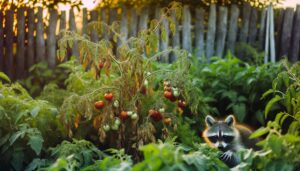Do Raccoons Eat Nyjer Seed?
Raccoons, as omnivorous mammals, have a highly adaptable diet that includes a variety of food sources such as fruits, nuts, insects, and small animals. They are also known to consume human refuse and other accessible foods in urban areas.
Nyjer seeds, which are oil-rich and nutrient-dense, attract finches and small songbirds but can also appeal to raccoons. Due to their foraging behaviors and dexterous forepaws, raccoons are capable of accessing bird feeders containing Nyjer seeds.
Implementing strategies to protect bird feeders can help mitigate this issue. Discovering additional methods of protecting your feeders can enhance your feeding experience.
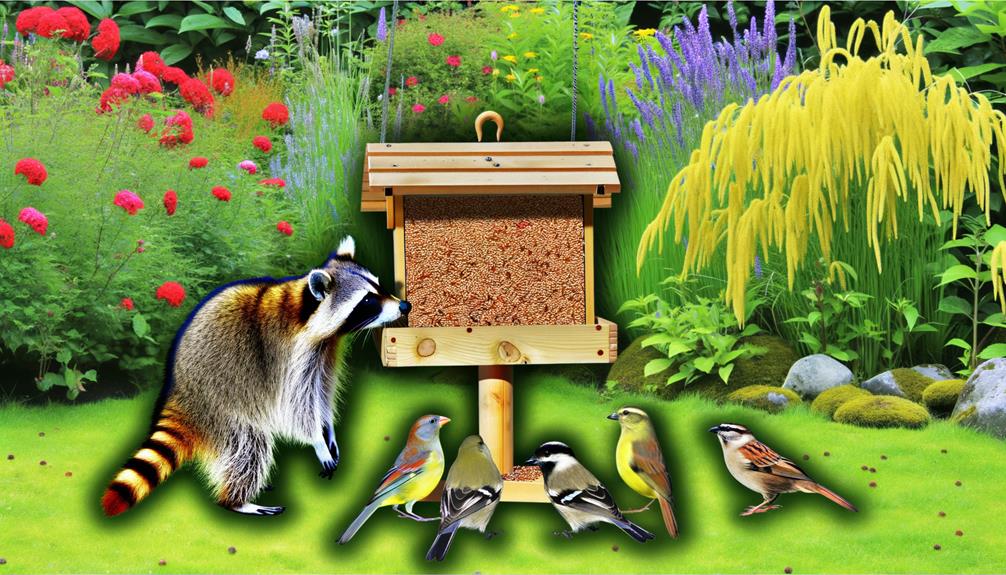
Key Takeaways
- Raccoons are omnivorous and can eat a wide variety of food, including seeds.
- Nyjer seeds are nutrient-dense and high in fat, making them attractive to raccoons.
- Raccoons' dexterous forepaws allow them to access bird feeders easily.
- Signs of raccoon activity near feeders include overturned bins and paw prints.
- Raccoon-proofing strategies, like using baffles and securing lids, can protect Nyjer seed feeders.
Raccoons' General Diet
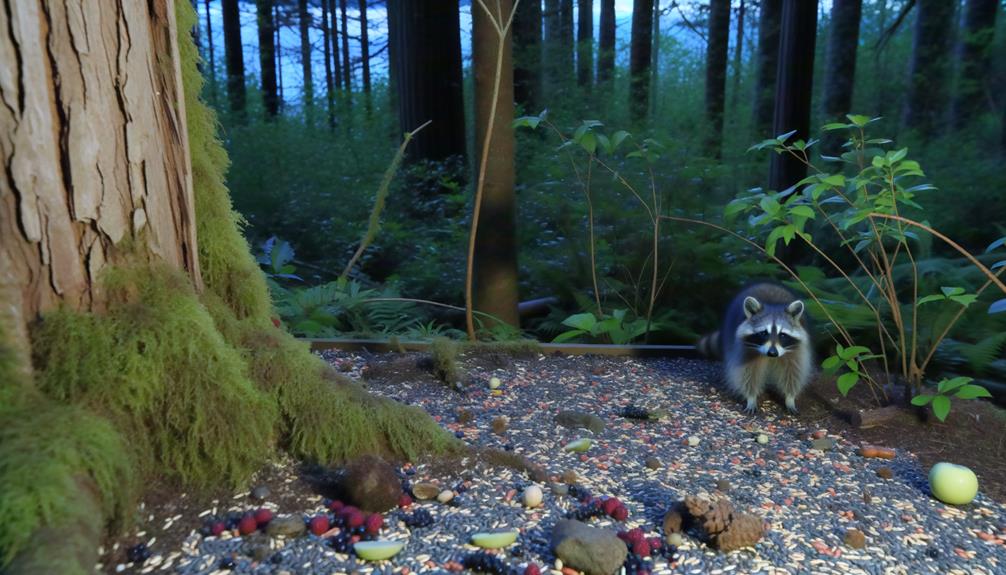
Raccoons (Procyon lotor) are omnivorous mammals with a highly varied diet that includes fruits, nuts, insects, small animals, and human refuse. Their dietary flexibility is a key factor in their widespread distribution across North America. The raccoon's opportunistic feeding behavior allows it to exploit diverse food sources depending on availability.
Seasonal variations significantly influence their diet; for instance, they consume more fruits and nuts in the autumn to build fat reserves for winter. In urban areas, raccoons frequently scavenge from garbage cans, bird feeders, and pet food dishes, demonstrating remarkable adaptability.
Such dietary diversity not only supports their survival but also impacts local ecosystems, as raccoons play roles in seed dispersal and pest control through their feeding habits.
Nyjer Seed Appeal
Nyjer seeds, also known as thistle seeds, are small, oil-rich seeds commonly used in bird feeders to attract finches and other small songbirds. These seeds are particularly appealing due to their high fat content, which provides essential energy for birds.
The seeds' diminutive size and distinctive shape make them especially suitable for the fine, specialized bills of species such as Goldfinches, Pine Siskins, and Common Redpolls.
Nyjer seeds are sterilized through heat treatment to prevent germination, ensuring they don't become invasive. Additionally, their dense nutrient profile includes crucial proteins, fats, and fibers, contributing to the overall health and strength of avian populations.
The unique composition and benefits of Nyjer seeds make them a highly valued resource in bird conservation efforts.
Raccoon Feeding Habits

While Nyjer seeds are a favorite among finches and small songbirds, the dietary preferences of raccoons are far more varied and opportunistic.
Raccoons (Procyon lotor) are omnivorous mammals known for their adaptability in both urban and rural environments. Their diet encompasses a wide range of food sources, including fruits, nuts, insects, small vertebrates, and human refuse.
They exhibit foraging behaviors that maximize caloric intake, often raiding garbage bins and bird feeders. Raccoons' dexterous forepaws allow them to manipulate objects and access food sources that other animals might find challenging.
This versatility in diet and foraging strategy underscores their success in diverse habitats, making them both resilient and resourceful predators and scavengers.
Signs of Raccoon Activity
Evidence of raccoon activity can often be identified through distinctive signs such as overturned garbage bins, scattered food remnants, and characteristic paw prints. Racoons leave behind five-toed tracks with a notable resemblance to tiny human hands, often visible in soft soil or mud.
Additionally, they are known to create latrines, areas where they consistently defecate, which can be found on flat surfaces like roofs or wood piles. Scratches on trees or structures can also indicate their presence, as raccoons climb to access food or shelter.
Nocturnal by nature, raccoons typically forage during the night, leaving signs of their presence by morning. Observing these indicators can help confirm raccoon activity in a given area, aiding in further management efforts.
Protecting Your Feeders
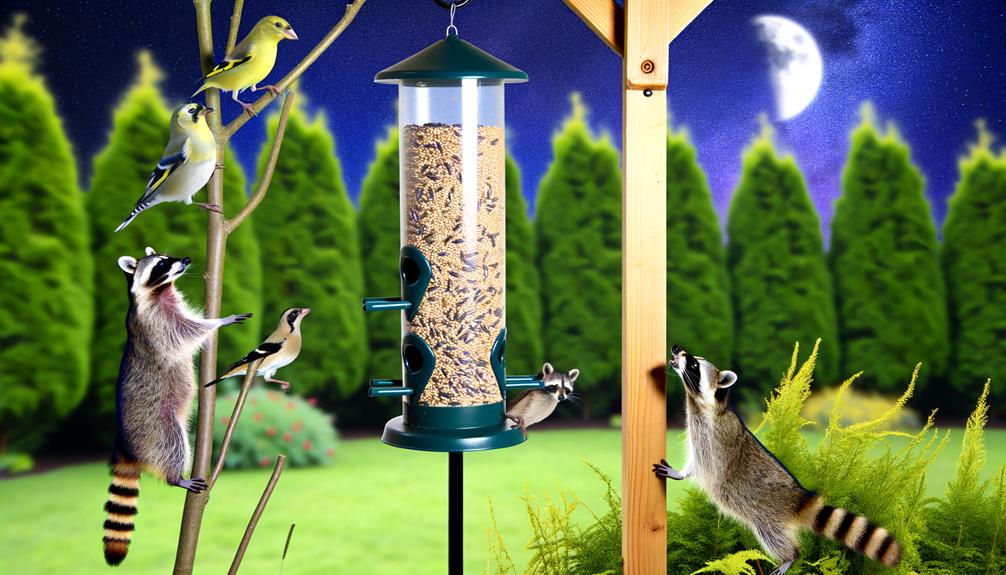
Given the telltale signs of raccoon activity, implementing effective strategies to protect your feeders becomes a priority to prevent these nocturnal visitors from accessing and depleting bird seed supplies.
One effective measure is the use of raccoon baffles, which are specifically designed to obstruct raccoons from climbing feeder poles.
Installing feeders at least 5 feet above the ground and 10 feet away from jump-off points like trees or fences also deters access.
Additionally, securing feeders with tightly fitting lids and using weight-sensitive mechanisms that close feeding ports when heavier animals are detected can further minimize raccoon interference.
Regular maintenance and inspection of these protective measures ensure their ongoing effectiveness in safeguarding bird seed from opportunistic raccoons.
Conclusion
Raccoons, known for their omnivorous diet, exhibit a preference for high-fat and high-protein foods, which may include nyjer seeds under certain conditions.
It has been observed that raccoons can consume up to 40% of their body weight in food during a single night.
Identifying signs of their activity, such as scattered seeds and feeder damage, is essential.
Employing strategies to protect bird feeders can mitigate raccoon interference, thereby ensuring the intended species benefit from the provided food.


